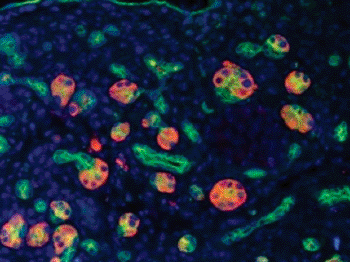Molecular Pathway Leads to Pancreatic Cancer
By LabMedica International staff writers
Posted on 25 Feb 2013
Cancer researchers have outlined the molecular pathway that regulates the transformation of normal pancreatic tissue into pancreatic ductal adenocarcinoma cells.Posted on 25 Feb 2013
Investigators at the University of Pennsylvania (Philadelphia, USA) profiled gene expression in mouse pancreatic tissues from several different biological states: during embryonic development, acute pancreatitis, and K-ras mutation-driven carcinogenesis. Of particular interest were changes that occurred in exocrine cells during acinar-ductal metaplasia (ADM), an inflammatory state that is a prelude to the development of pancreatic ductal adenocarcinoma.

Image: An intermediate cell type, which emerges during inflammation and regeneration in acute pancreatitis regulated by the transcription factor Prrx1, termed acinar-to-ductal metaplasia (Photo courtesy of Maximilian Reichert, MD, Perelman School of Medicine, University of Pennsylvania).
They reported in the February 2013 issue of the journal Genes and Development that the protein Prrx1 (paired related homeobox 1) was a key element in the pathway leading to transformation into cancer. Prxx1 is a DNA-associated protein that is a member of the paired family of homeobox proteins localized to the nucleus. The protein functions as a transcription coactivator, enhancing the DNA-binding activity of serum response factor, a protein required for the induction of genes by growth and differentiation factors.
Results of the current study revealed that Prxx1was present in two isoforms, Prrx1a and Prrx1b. Prxx1a was shown to regulate migration while Prxx1b regulated invasion in pancreatic cancer cells and was enriched in circulating pancreatic cells. Additionally, the Prrx1b isoform, which was also induced in ADM, bound the Sox9 promoter and positively regulated Sox9 expression. This finding suggested a new hierarchical scheme whereby a Prrx1–Sox9 axis may influence the emergence of ADM and regeneration.
“We hope that studies like this one that identifies key molecules and pathways that govern the cancerous fate of cells can be used as diagnostic predictors of treatment outcome and severity for cancer,” said senior author Dr. Anil Rustgi, professor of gastroenterology at the University of Pennsylvania.
Related Links:
University of Pennsylvania










 (3) (1).png)



